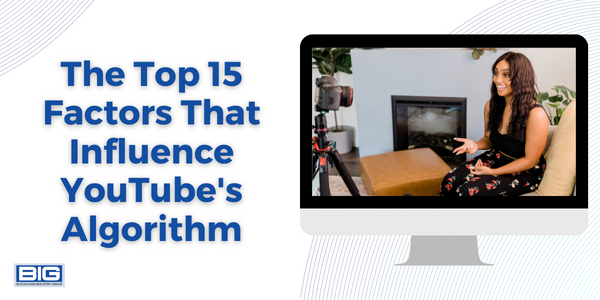
In today’s digital age, YouTube has become one of the most popular and influential platforms for sharing video content. With over 2 billion monthly active users, YouTube’s algorithm plays a crucial role in determining which videos are recommended to viewers. Understanding the factors that influence the algorithm is essential for any content creator or marketer looking to succeed on the platform. In this blog, we will explore the top 15 factors that influence YouTube’s algorithm and how you can use this knowledge to improve the performance of your videos on the platform.
- Watch Time: the amount of time a viewer spends watching a video is one of the most important factors that YouTube considers in its algorithm. Videos that have higher watch time are more likely to be recommended to other users.
- Engagement: the level of engagement with a video, including likes, comments, and shares, also plays a significant role in YouTube’s algorithm. Videos that receive high levels of engagement are more likely to be recommended to other users.
- Relevance: the relevance of a video’s content to a viewer’s interests is another important factor in YouTube’s algorithm. The platform uses a variety of signals, such as search queries and watch history, to understand a viewer’s interests and recommend videos accordingly
- Quality: the quality of a video’s production, including factors such as audio and visual quality, also plays a role in YouTube’s algorithm. Higher quality videos are more likely to be recommended to viewers.
- Consistency: the consistency of a channel’s content and upload schedule is another factor that YouTube considers in its algorithm. Channels that regularly upload high-quality videos on a consistent schedule are more likely to be recommended to viewers.
- Click-Through Rate (CTR): the CTR is the percentage of users who click on a video after seeing it in search results or recommendations. Videos with a high CTR are more likely to be recommended to other users.
- Session Time: the amount of time a user spends on YouTube after watching a video can also impact the algorithm. If a viewer watches a video and then continues to watch other videos on the platform, it signals to YouTube that the initial video was engaging and relevant.
- Audience Retention: the percentage of a video that a viewer watches is also considered by YouTube’s algorithm. Videos with higher audience retention rates are more likely to be recommended to other users.
- Metadata: the metadata of a video, such as the title, description, and tags, can also impact YouTube’s algorithm. Including relevant keywords in these fields can help YouTube better understand the content of a video and recommend it to the appropriate audience.
- Channel Authority: the authority of a channel, which is determined by factors such as the number of subscribers and the level of engagement with videos, can also play a role in YouTube’s algorithm. Channels with a higher level of authority are more likely to have their videos recommended to viewers.
- Video Length: the length of a video can also impact YouTube’s algorithm. While there is no hard and fast rule, longer videos (e.g., over 10 minutes) tend to perform better in the algorithm, as they can generate more watch time and ad revenue.
- Language and Location: the language and location of a viewer can also influence the algorithm. YouTube will recommend videos in the viewer’s preferred language, and videos that are relevant to their geographic location.
- Hashtags: the use of hashtags in video titles and descriptions can help YouTube understand the topic of the video and recommend it to relevant audiences. However, it’s important to use relevant hashtags, as irrelevant or spammy tags can hurt a video’s performance in the algorithm.
- Shares: the number of times a video is shared on social media or embedded on other websites can also impact YouTube’s algorithm. Videos that are widely shared are more likely to be recommended to other users.
- Thumbnail: the thumbnail image that appears next to a video in search results and recommendations can also influence the algorithm. Eye-catching and relevant thumbnails can help increase click-through rates and improve a video’s performance in the algorithm.
10 LinkedIn Tools for Lead Generation
—
10 Reasons to Join LinkedIn Groups
—
12 Guerilla Marketing Strategies & Techniques
In conclusion, YouTube’s algorithm is a complex and ever-evolving system that considers a wide range of factors when recommending videos to users. By optimizing for these factors, content creators and marketers can increase the visibility and engagement of their videos on the platform. However, it’s important to remember that creating high-quality and engaging content is still the most critical factor for success on YouTube. By combining great content with a deep understanding of the algorithm, creators and marketers can unlock the full potential of the platform and reach a massive audience of engaged viewers.



